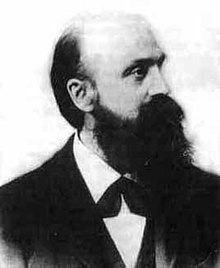Wilhelm Killing
Wilhelm Karl Joseph Killing | |
|---|---|
 | |
| Born | 10 May 1847 |
| Died | 11 February 1923(aged 75) |
| Citizenship | German |
| Known for | Lie algebras,Lie groups, andnon-Euclidean geometry |
| Spouse | Anna Commer |
| Awards | Lobachevsky Prize(1900) |
| Scientific career | |
| Fields | Mathematics |
| Doctoral advisor | Karl Weierstrass Ernst Kummer |
Wilhelm Karl Joseph Killing(10 May 1847 – 11 February 1923) was a Germanmathematicianwho made important contributions to the theories ofLie algebras,Lie groups,andnon-Euclidean geometry.
Life
[edit]Killing studied at theUniversity of Münsterand later wrote his dissertation underKarl WeierstrassandErnst Kummerat Berlin in 1872. He taught in gymnasia (secondary schools) from 1868 to 1872. In 1875, he married Anna Commer, who was the daughter of a music lecturer. He became a professor at the seminary collegeCollegium Hosianumin Braunsberg (nowBraniewo). He took holy orders in order to take his teaching position. He became rector of the college and chair of the town council. As a professor and administrator, Killing was widely liked and respected. Finally, in 1892 he became a professor at the University of Münster.[1]
In 1886, Killing and his wife entered theThird Order of Franciscans.[1]
Work
[edit]In 1878 Killing wrote onspace formsin terms ofnon-Euclidean geometryinCrelle's Journal,which he further developed in 1880 as well as in 1885.[2]Recounting lectures of Weierstrass, he there introduced thehyperboloid modelofhyperbolic geometrydescribed byWeierstrass coordinates.[3]He is also credited with formulating transformations mathematically equivalent toLorentz transformationsinndimensions in 1885.[4]
Killing inventedLie algebrasindependently ofSophus Liearound 1880. Killing's university library did not contain the Scandinavian journal in which Lie's article appeared. (Lie later was scornful of Killing, perhaps out of competitive spirit and claimed that all that was valid had already been proven by Lie and all that was invalid was added by Killing.) In fact Killing's work was less rigorous logically than Lie's, but Killing had much grander goals in terms of classification of groups, and made a number of unproven conjectures that turned out to be true. Because Killing's goals were so high, he was excessively modest about his own achievement.[citation needed]
From 1888 to 1890, Killing essentially classified the complex finite-dimensionalsimple Lie algebras,as a requisite step of classifying Lie groups, inventing the notions of aCartan subalgebraand theCartan matrix.He thus arrived at the conclusion that, basically, the only simple Lie algebras were those associated to the linear, orthogonal, and symplectic groups, apart from a small number of isolated exceptions.Élie Cartan's 1894 dissertation was essentially a rigorous rewriting of Killing's paper. Killing also introduced the notion of aroot system.He discovered theexceptional Lie algebrag2in 1887; his root system classification showed up all the exceptional cases, but concrete constructions came later.
As A. J. Coleman says, "He exhibited the characteristic equation of theWeyl groupwhen Weyl was 3 years old and listed the orders of theCoxeter transformation19 years beforeCoxeterwas born. "[5]
Selected works
[edit]- Work on non-Euclidean geometry
- Killing, W. (1878) [1877]."Ueber zwei Raumformen mit constanter positiver Krümmung".Journal für die reine und angewandte Mathematik.86:72–83.
- Killing, W. (1880) [1879]."Die Rechnung in den Nicht-Euklidischen Raumformen".Journal für die reine und angewandte Mathematik.89:265–287.
- Killing, W. (1885) [1884]."Die Mechanik in den Nicht-Euklidischen Raumformen".Journal für die reine und angewandte Mathematik.98:1–48.
- Killing, W. (1885).Die nicht-euklidischen Raumformen.Leipzig: Teubner.
- Killing, W. (1891)."Ueber die Clifford-Klein'schen Raumformen".Mathematische Annalen.39(2): 257–278.doi:10.1007/bf01206655.S2CID119473479.
- Killing, W. (1892)."Ueber die Grundlagen der Geometrie".Journal für die reine und angewandte Mathematik.109:121–186.
- Killing, W. (1893)."Zur projectiven Geometrie".Mathematische Annalen.43(4): 569–590.doi:10.1007/bf01446454.S2CID121748880.
- Killing, W. (1893).Einführung in die Grundlagen der Geometrie I.Paderborn: Schöningh.
- Killing, W. (1898) [1897].Einführung in die Grundlagen der Geometrie II.Paderborn: Schöningh.
- Work on transformation groups
- Killing, W. (1888)."Die Zusammensetzung der stetigen endlichen Transformationsgruppen".Mathematische Annalen.31(2): 252–290.doi:10.1007/bf01211904.S2CID120501356.
- Killing, W. (1889)."Die Zusammensetzung der stetigen endlichen Transformationsgruppen. Zweiter Theil".Mathematische Annalen.33:1–48.doi:10.1007/bf01444109.S2CID124198118.
- Killing, W. (1889)."Die Zusammensetzung der stetigen endlichen Transformationsgruppen. Dritter Theil".Mathematische Annalen.34:57–122.doi:10.1007/BF01446792.S2CID179177899.
- Killing, W. (1890)."Erweiterung des Begriffes der Invarianten von Transformationsgruppen".Mathematische Annalen.35(3): 423–432.doi:10.1007/bf01443863.S2CID121050972.
- Killing, W. (1890)."Die Zusammensetzung der stetigen endlichen Transformationsgruppen. Vierter Theil".Mathematische Annalen.36:161–189.doi:10.1007/bf01207837.S2CID179178061.
- Killing, W. (1890)."Bestimmung der grössten Untergruppen von endlichen Transformationsgruppen".Mathematische Annalen.36(2): 239–254.doi:10.1007/bf01207841.S2CID121548146.
See also
[edit]- Killing equation
- Killing form
- Killing–Hopf theorem
- Killing horizon
- Killing spinor
- Killing tensor
- Killing vector field
- Levi decomposition
- G2 (mathematics)
- Root system
References
[edit]- ^abO'Conner, J. J.; Robertson, E. F. (February 2005)."Wilhelm Killing - Biography".MacTutor.Retrieved2023-08-23.
- ^Hawkins, Thomas (2000).Emergence of the Theory of Lie Groups.New York: Springer.ISBN0-387-98963-3.
- ^Reynolds, W. F. (1993). "Hyperbolic geometry on a hyperboloid".The American Mathematical Monthly.100(5): 442–455.doi:10.1080/00029890.1993.11990430.JSTOR2324297.S2CID124088818.
- ^Ratcliffe, J. G. (1994)."Hyperbolic geometry".Foundations of Hyperbolic Manifolds.New York. pp.56–104.ISBN038794348X.
{{cite book}}:CS1 maint: location missing publisher (link) - ^Coleman, A. John, "The Greatest Mathematical Paper of All Time,"The Mathematical Intelligencer,vol. 11, no. 3, pp. 29–38.
External links
[edit]- O'Connor, John J.;Robertson, Edmund F.,"Wilhelm Killing",MacTutor History of Mathematics Archive,University of St Andrews
![]() Media related toWilhelm Killing (mathematician)at Wikimedia Commons
Media related toWilhelm Killing (mathematician)at Wikimedia Commons
